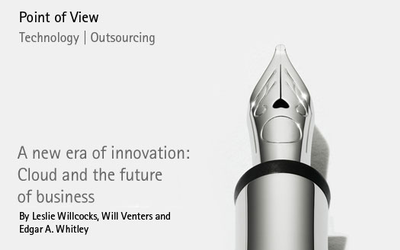A COMMONLY held belief is that cloud computing — a utility model for computing capacity, software and business functionality — is a phenomenon whose value resides primarily in reducing IT costs. In fact, the flexibility that the cloud makes possible for infrastructures, services and processes means that it is also capable of driving significant innovation.
This is a key finding of research from the London School of Economics and Accenture, based on a survey of 1,035 business and IT executives, as well as in-depth interviews with more than 35 service providers and other stakeholders.
The innovation trajectory of the cloud will be cumulative. Beginning first with technology and operational changes, its effects will then be felt at the business process level, changing the way companies operate and serve customers. It will be capable of delivering market innovations that enhance existing products and services, create new ones and enable entry into new markets. Finally, the cloud will support new ways of designing corporations themselves.
Reducing the friction: operational innovation
One of the key ways that cloud computing supports operational and technological innovation is by moving an organisation more briskly through the experimental or prototyping stages — or, as some of our interviewees put it, by "reducing the friction" of development. In a cloud model, companies acquire processing, storage or services when they need them, then can quickly decommission those resources when they are not needed.
Such a model supports "seed and grow" activities and faster prototyping of ideas. With traditional IT models, a decision to prototype a new system generally involves the procurement and installation of expensive hardware, with the associated checks and delays that conventional purchasing requires. Cloud provisioning, on the other hand, can be implemented rapidly and at low cost.
That means the cloud can also reduce the risks of operational innovation. Projects and processes that would have been too risky to attempt if they required a large capital investment become worth attempting if unsuccessful experiments can be decommissioned easily.
Language of the business: process innovation
A distinctive feature of cloud computing is its ability to hide the technical complexity of solutions. The acquisition and deployment of IT becomes almost secondary. Companies are actually deploying a process or service, and that means business and IT executives need no longer try to communicate across a technology gap. They can speak a common language about what the business seeks to do and how it intends to do it.
Steve Furminger, group chief technology officer of global digital marketing agency RAPP UK, underscores this point by noting that the cloud is providing his company with the ability to produce solutions more rapidly without needing to be concerned at such a detailed level about how they are going to do it from a technical perspective: "Just a few years ago, that was a massive concern. Now we can almost forget the technology and just think in terms of what we want to do from a business perspective."
To illustrate this point, consider an organisation’s desire to innovate within its processes and technologies related to sales support — the ability to track contacts, manage and convert the sales pipeline, and generate revenue. With older models of IT solutions, a company would be restricted to particular packages or platforms — forced, in other words, to change its processes to match the software. With a cloud model, companies can think about processes at a level that is more detailed and personalised to their individual needs, but the solution will not need to be customised in older, prohibitively expensive ways. The company could provision a combination of software as a service for sales, along with an enterprise system or financial management system. Sales personnel could have access to specialised sales support over the cloud.
This ability to envision new combinations of cloud-based solutions and create new ways of performing end-to-end processes presents companies with new opportunities to be innovative in new-product development as well as in service and support.
Alignment of development cycles: business innovation
Information technologies from their earliest days have represented enormous potential to deliver game-changing innovations. Although IT has become the lifeblood of the modern corporation, the path from point A (IT innovation) to point B (business value) has often been a tortuous one.
In part, this is because IT capability cycles and business demand cycles have rarely coincided. It has often taken up to 10 years for a new, major IT capability (client/server computing, for example) to be fully realised in terms of business value, while most businesses operate on near-term planning horizons. But the short development times made possible by cloud computing mean that business and technology have reached a fortuitous point in both cycles where they intersect.
This alignment enables IT innovation to more effectively drive business innovation. Service providers must maintain constant relevance. As Tim Barker, vice president of strategy for Europe, Middle East and Africa of Salesforce.com notes, subscriptions or renewals are due every quarter or even every month. This supports the alignment of a company’s entire business to the success of that project and the success of the customer.
Although moving to the cloud may be disruptive to the existing IT function, it enables CIOs to have meaningful answers to board-level questions about the value being delivered by the current organisational IT environment, including how much it costs and how quickly new services can be provisioned.
The next phase: innovation in business design
For especially forward-looking companies, cloud computing may provide a platform for radical innovation in business design — to the point where executives are actually provisioning and decommissioning parts of the business on an as-needed basis.
This is a step beyond software as a service or infrastructure as a service, and amounts to the offering of "business processes as a service" — configured business services and processes provided from the cloud. These would be assessed not just through typical service-level agreements but against key business performance indicators.
Although extremely promising in concept, the idea of adaptive business design heightens the importance of the integrator role. The traditional systems integrator would become, in effect, a business integrator charged with managing complex collaborations across a broader ecosystem of internal resources, partners, vendors and others. As business design or business architecture innovators, integrators would connect and manage business services in configurations that change as business needs and goals change.
Such collaborative, innovative relationships hint at a new agile and adaptive organisational form. Knowing what such a corporation might look like is difficult, but we can see glimpses of it by looking beyond the business community to the organisation of particle physicists working at CERN on the Large Hadron Collider (LHC).
To make possible the staggering 15-million gigabytes of data that are being produced every year by the LHC’s experiments, there was a need to create a global organisation of collaborators. More than 140 computer centres (each part of a university or research facility) work together to pool their processing resources into a grid computing infrastructure. A globally distributed platform–based on cloud technologies and run as a service — was developed. It is managed collectively by a loosely organised confederation of physicists and their data centres.
Organisational governance in this environment evolves to match the challenges and opportunities. The new organisation connects the computer centres through loose memoranda of understanding and business processes, particularly around support, data analysis and technology upgrades. The bureaucratic hierarchies are limited in scope and power, and most work is achieved through collaboration among equals. This structure provides a kind of first look at how an agile, innovative global organisation can be created when founded upon collaboration and shared cloud-based technology.
Some companies will perform better than others, of course, when it comes to harnessing cloud-based innovation. Organisational readiness will be key — that is, the ability of the corporate culture and leadership to recognise innovation-based opportunity and move quickly — as will implementation abilities. Above all, companies who are able to collaborate across a wider ecosystem of internal and external players will be at an advantage in capitalising on the responsiveness and agility that the cloud delivers to the business.
• Professor Leslie Willcocks, Dr Will Venters and Dr Edgar A Whitley are in the outsourcing unit of the department of management at the London School of Economics and Political Science.

A new era of innovation: cloud and the future of business
A COMMONLY held belief is that cloud computing — a utility model for computing capacity, software and business functionality — is a phenomenon whose value resides primarily in reducing IT costs. In fact, the flexibility that the cloud makes possible for infrastructures, services and processes means that it is also capable of driving significant innovation.
This is a key finding of research from the London School of Economics and Accenture, based on a survey of 1,035 business and IT executives, as well as in-depth interviews with more than 35 service providers and other stakeholders.
The innovation trajectory of the cloud will be cumulative. Beginning first with technology and operational changes, its effects will then be felt at the business process level, changing the way companies operate and serve customers. It will be capable of delivering market innovations that enhance existing products and services, create new ones and enable entry into new markets. Finally, the cloud will support new ways of designing corporations themselves.
Reducing the friction: operational innovation
One of the key ways that cloud computing supports operational and technological innovation is by moving an organisation more briskly through the experimental or prototyping stages — or, as some of our interviewees put it, by "reducing the friction" of development. In a cloud model, companies acquire processing, storage or services when they need them, then can quickly decommission those resources when they are not needed.
Such a model supports "seed and grow" activities and faster prototyping of ideas. With traditional IT models, a decision to prototype a new system generally involves the procurement and installation of expensive hardware, with the associated checks and delays that conventional purchasing requires. Cloud provisioning, on the other hand, can be implemented rapidly and at low cost.
That means the cloud can also reduce the risks of operational innovation. Projects and processes that would have been too risky to attempt if they required a large capital investment become worth attempting if unsuccessful experiments can be decommissioned easily.
Language of the business: process innovation
A distinctive feature of cloud computing is its ability to hide the technical complexity of solutions. The acquisition and deployment of IT becomes almost secondary. Companies are actually deploying a process or service, and that means business and IT executives need no longer try to communicate across a technology gap. They can speak a common language about what the business seeks to do and how it intends to do it.
Steve Furminger, group chief technology officer of global digital marketing agency RAPP UK, underscores this point by noting that the cloud is providing his company with the ability to produce solutions more rapidly without needing to be concerned at such a detailed level about how they are going to do it from a technical perspective: "Just a few years ago, that was a massive concern. Now we can almost forget the technology and just think in terms of what we want to do from a business perspective."
To illustrate this point, consider an organisation’s desire to innovate within its processes and technologies related to sales support — the ability to track contacts, manage and convert the sales pipeline, and generate revenue. With older models of IT solutions, a company would be restricted to particular packages or platforms — forced, in other words, to change its processes to match the software. With a cloud model, companies can think about processes at a level that is more detailed and personalised to their individual needs, but the solution will not need to be customised in older, prohibitively expensive ways. The company could provision a combination of software as a service for sales, along with an enterprise system or financial management system. Sales personnel could have access to specialised sales support over the cloud.
This ability to envision new combinations of cloud-based solutions and create new ways of performing end-to-end processes presents companies with new opportunities to be innovative in new-product development as well as in service and support.
Alignment of development cycles: business innovation
Information technologies from their earliest days have represented enormous potential to deliver game-changing innovations. Although IT has become the lifeblood of the modern corporation, the path from point A (IT innovation) to point B (business value) has often been a tortuous one.
In part, this is because IT capability cycles and business demand cycles have rarely coincided. It has often taken up to 10 years for a new, major IT capability (client/server computing, for example) to be fully realised in terms of business value, while most businesses operate on near-term planning horizons. But the short development times made possible by cloud computing mean that business and technology have reached a fortuitous point in both cycles where they intersect.
This alignment enables IT innovation to more effectively drive business innovation. Service providers must maintain constant relevance. As Tim Barker, vice president of strategy for Europe, Middle East and Africa of Salesforce.com notes, subscriptions or renewals are due every quarter or even every month. This supports the alignment of a company’s entire business to the success of that project and the success of the customer.
Although moving to the cloud may be disruptive to the existing IT function, it enables CIOs to have meaningful answers to board-level questions about the value being delivered by the current organisational IT environment, including how much it costs and how quickly new services can be provisioned.
The next phase: innovation in business design
For especially forward-looking companies, cloud computing may provide a platform for radical innovation in business design — to the point where executives are actually provisioning and decommissioning parts of the business on an as-needed basis.
This is a step beyond software as a service or infrastructure as a service, and amounts to the offering of "business processes as a service" — configured business services and processes provided from the cloud. These would be assessed not just through typical service-level agreements but against key business performance indicators.
Although extremely promising in concept, the idea of adaptive business design heightens the importance of the integrator role. The traditional systems integrator would become, in effect, a business integrator charged with managing complex collaborations across a broader ecosystem of internal resources, partners, vendors and others. As business design or business architecture innovators, integrators would connect and manage business services in configurations that change as business needs and goals change.
Such collaborative, innovative relationships hint at a new agile and adaptive organisational form. Knowing what such a corporation might look like is difficult, but we can see glimpses of it by looking beyond the business community to the organisation of particle physicists working at CERN on the Large Hadron Collider (LHC).
To make possible the staggering 15-million gigabytes of data that are being produced every year by the LHC’s experiments, there was a need to create a global organisation of collaborators. More than 140 computer centres (each part of a university or research facility) work together to pool their processing resources into a grid computing infrastructure. A globally distributed platform–based on cloud technologies and run as a service — was developed. It is managed collectively by a loosely organised confederation of physicists and their data centres.
Organisational governance in this environment evolves to match the challenges and opportunities. The new organisation connects the computer centres through loose memoranda of understanding and business processes, particularly around support, data analysis and technology upgrades. The bureaucratic hierarchies are limited in scope and power, and most work is achieved through collaboration among equals. This structure provides a kind of first look at how an agile, innovative global organisation can be created when founded upon collaboration and shared cloud-based technology.
Some companies will perform better than others, of course, when it comes to harnessing cloud-based innovation. Organisational readiness will be key — that is, the ability of the corporate culture and leadership to recognise innovation-based opportunity and move quickly — as will implementation abilities. Above all, companies who are able to collaborate across a wider ecosystem of internal and external players will be at an advantage in capitalising on the responsiveness and agility that the cloud delivers to the business.
• Professor Leslie Willcocks, Dr Will Venters and Dr Edgar A Whitley are in the outsourcing unit of the department of management at the London School of Economics and Political Science.






















Change: -1.52%
Change: -1.70%
Change: -1.84%
Change: -1.60%
Change: -1.52%
Data supplied by Profile Data
Change: -0.64%
Change: 0.12%
Change: -1.52%
Change: 0.00%
Change: 0.10%
Data supplied by Profile Data
Change: 0.73%
Change: -0.11%
Change: 0.63%
Change: 1.18%
Change: 1.40%
Data supplied by Profile Data
Change: 0.72%
Change: 0.71%
Change: -0.13%
Change: 0.33%
Change: -0.15%
Data supplied by Profile Data